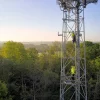Delayed 4G Emergency Services Network Adopts Phased Roll-out
The UK Government appears to have finally given up on their original and much delayed deployment plan for the new £1.2bn Emergency Services Network (ESN), which will be rolled out by the Home Office using 4G technology (supported by EE, Motorola and KBR). It’s now going to take a lot longer.
At present some 200,000+ police, fire and other emergency service(s) users make use of the Motorola-owned Airwave network, which is believed to cost the UK around £3bn and harnesses TETRA (Terrestrial Trunked Radio) technology. The TETRA network is slow (dialup like data speeds) and expensive, but it also delivers excellent voice coverage (c.97% geographic reach).
The high cost is often highlighted as one of the reasons why the government in 2015 decided to replace Airwave with a 4G solution (the first country to do so). The new network was originally due to begin its roll-out in 2017 and to finish by December 2019, but problems with delivering the desired level of coverage (especially underground) and software/hardware readiness soon put pay to that idea (here and here).
Advertisement
Now the Home Office has announced a new “new strategic direction” for the ESN, which essentially means that they’ve decided to “roll the project out in phases“. Under this plan the first emergency services will “begin” harnessing the new mobile-based communications network from January 2019.
Home Office Statement
The decision secures the future of ESN, which will save the public purse £200 million a year once it has fully replaced the original radio-based network, Airwave.
The new incremental approach means police, fire and rescue services, ambulance services and other users will be able to use data services over the network from early next year, with voice capabilities following soon after.
It will also leave the emergency services free to test and choose which ESN products they want as and when they become available, rather than having to wait for the network to be fully implemented.
At the same time Motorola has agreed to extend the use of their existing Airwave network for three additional years to 31st December 2022, with the “option to be further extended” if required. Previous reports have indicated that extending this could cost anything from around £360m to £475m per year, which puts the Government’s claim of saving £200m per year (once the new ESN is fully implemented) into a different light.
To allow for the new phased deployment strategy, the Motorola Solutions ESN agreement will also be extended by 30 months through the end of 2024.
Kelly Mark, Motorola’s Executive VP of Services and Software, said:
“We are proud to support the Home Office on its new delivery approach for ESN while at the same time ensuring public safety users have the Airwave communications network they need. We have been working closely with the Home Office to ensure that our services are aligned with this new phased deployment and timeline for ESN.”
The only other alternative considered for the ESN was a drastic shut-down (i.e. get the technology sorted properly first), which we’re certain would have made for some rather unsavoury headlines. In other words, it’s easy to see why they opted for a slower phased approach to the deployment, even though it’s still a big delay.
Advertisement
Nevertheless it remains to be seen whether the new ESN will meet even the revised objectives, although it’s certainly in a better position to do so now than it was three years ago. The original deployment timetable always seemed rather optimistic, perhaps even fanciful. We should point out that the 4G side of the new network, which is coming from EE, is allegedly on-track. It seems to be everything else that’s the problem.
Mark is a professional technology writer, IT consultant and computer engineer from Dorset (England), he also founded ISPreview in 1999 and enjoys analysing the latest telecoms and broadband developments. Find me on X (Twitter), Mastodon, Facebook, BlueSky, Threads.net and Linkedin.
« Virgin Media UK’s FTTP Rural Community Broadband Build is Live
















































Comments are closed